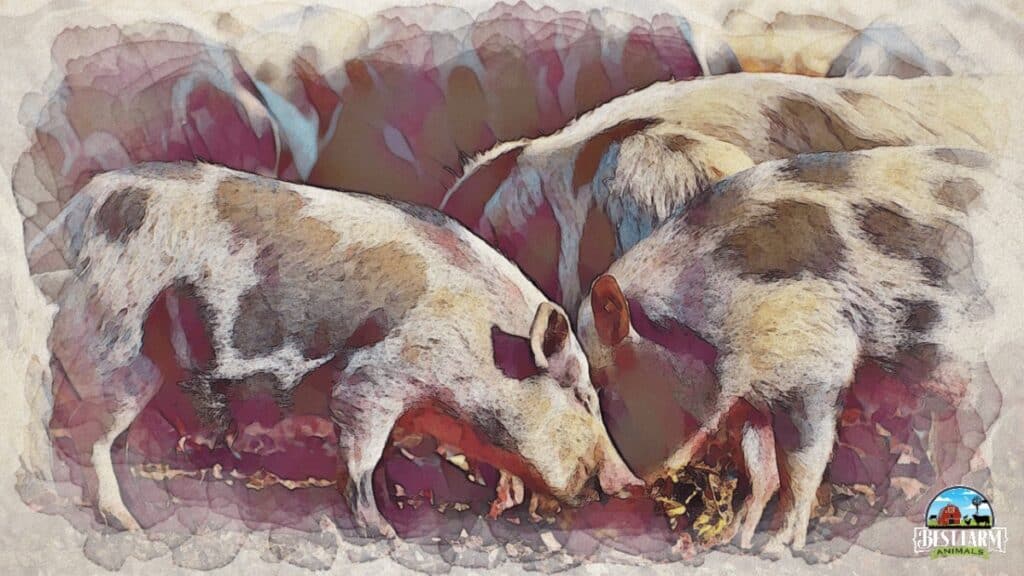Pig dysentery, porcine rotavirus, or swine influenza are examples of infectious diseases that can be seen in pigs who aren’t eating and have diarrhea. Other factors that can contribute to a pig not eating and diarrhea include poor nutrition, a change in diet, and environmental stressors.
Pigs with infectious diseases may exhibit severe symptoms and need to be treated immediately. Weight loss, severe diarrhea, and appetite loss are all effects of swine dysentery. Pigs that show symptoms of porcine rotavirus may vomit and have diarrhea. On the other hand, swine influenza can result in fever, coughing, and decreased appetite in addition to diarhhea.
Swine Dysentery
Swine dysentery (SD) is a highly infectious disease caused by the bacteria Brachyspira hyodysenteriae. It causes diarrhea, often with blood in the stool. A loss of body weight, and listlessness, also accompany SD. This disease wreaks havoc on pig farms and is responsible for severe economic losses from infected herds (that must be isolated and receive costly medications).
This organism thrives in cool and moist environments, and once the bacteria infects the pig, it breeds in their colon. The pig suffers from severe diarrhea and inflammation of the large colon.
Humans aren’t affected by the Swine dysentery bacteria. However, they can carry the bacteria on their boots or clothing and pass it on to the pigs. Pigs of all ages can be infected with SD. However, it’s rarely seen in piglets under three weeks old.
Causes of Swine Dysentery
The leading cause of Swine dysentery is when pigs ingest contaminated feces. This bacteria can survive up to 2 months in moist feces. It’s essential to keep your pig’s living environment clean to avoid the spread of bacteria. Therefore, scrub your pig sties weekly with a strong disinfectant.
Infected rats and mice can also carry this disease to your pigs. Other ways that this disease can be transmitted are by birds, flies, and mites. Carrier pigs can have the disease and spread it for almost 90 days.
Symptoms of Swine Dysentery
Pigs with swine dysentery often have wasting syndrome. They stop growing or lose weight, look lethargic, and may have blood in their stool. Pigs are often hunched, look haggard, and have sunken eyes or twitching tails. They will look ill.
- Yellowish-gray diarrhea that has a slimy coating or mucus
- Fresh blood is present in the stool
- Fecal material may ooze out of the anus and cover your pig’s hind legs
- Twitching tail
- Hunched over
- Haggard appearance
- Sunken eyes
- Loss of appetite
- Severe cases can lead to sudden death
Treating Swine Dysentery
The infected pig or herd should be in quarantine for at least 30 to 60 days to avoid spreading the disease. Antibiotics such as Carbadox, Tiamulin, and Lincomycin need to be administered. Unfortunately, antibiotic resistance is increasing, which makes a long-term strategy difficult.
Keep your pigs’ living area clean, and disinfect their pens regularly to avoid the growth of bacteria and further spread of the disease. Currently, there is no vaccine available for this disease. You will need to rely on antibiotics and preventative measures to keep this disease under control.
References
Iowa State University College of Veterinary Science Swine Dysentery and Spirochaetal Colitis
My Most Used Pig Supplies
This list contains affiliate products. Affiliate products do not cost more but helps to support BestFarmAnimals and our goal to provide farm animal owners with accurate and helpful information.
Purina Pig Chow will last well (or Mazuri is popular, but I haven’t tried it), and the stainless steel non-skid bowls that will help keep the mess down.
A pig blanket to keep her warm. This one also has bright colors and helps to provide rooting without the destruction.
Pig Harness for walking and handling your pig. There are a lot to choose from, but this one is pretty easy to use. If you want one that has a separate leash, this looks like a good one.
A large crate for keeping her safe in your house at night and when you leave the house. This is essential. You’ll also want a litterbox, and I like mine with a lid for nighttime. Pine shavings are best, and you may be able to find them in larger quantities locally.
When you have accidents, Odoban will help eliminate odors. When you are potty training, these floor pads work great for keeping your house clean while training her to go in certain places.
You’ll also want an outdoor house to keep her warm when she gets outside time, an essential part of her development.
Dewormer- Ivermectin is the primary dewormer I use, although I do rotate with a non-ivermect ingredient once so that the worms don’t get immune to it.

